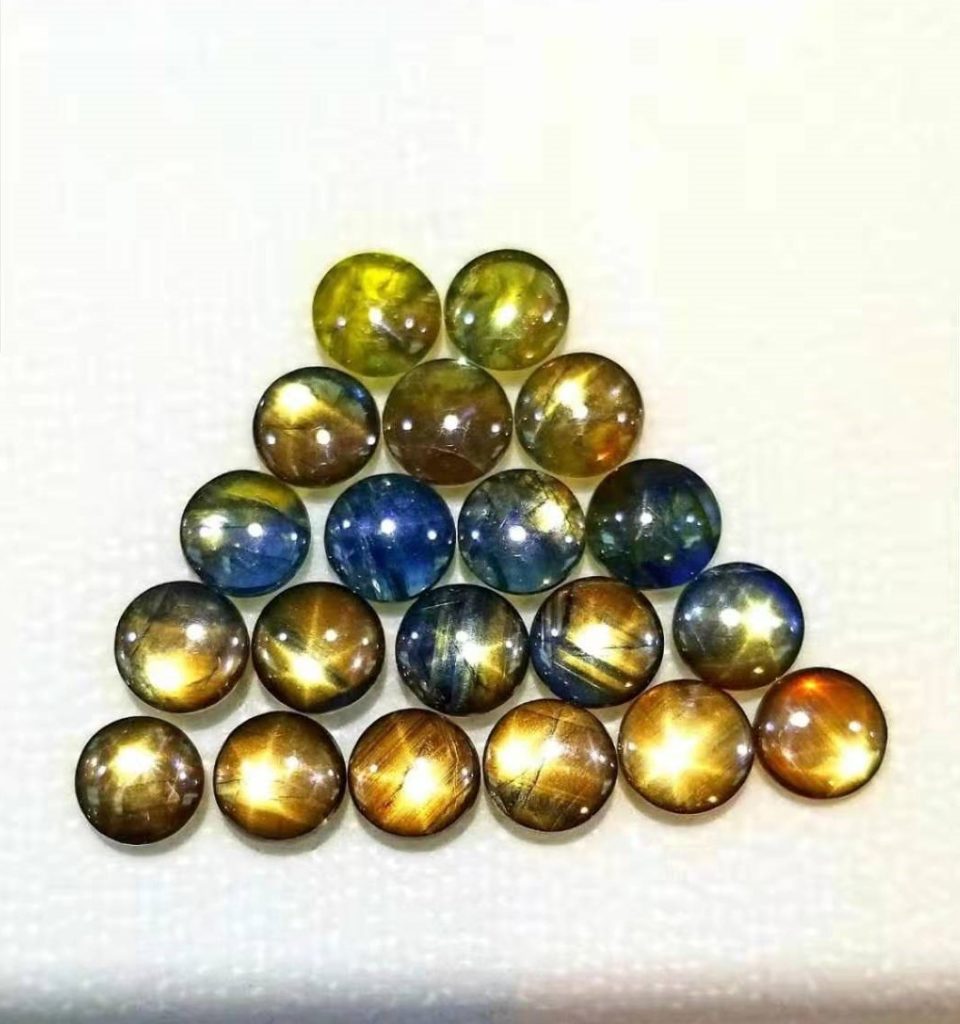What is Gold Sheen Sapphire, and why is it different from other varieties of corundum?
This is an important question because gold sheen sapphire can sell for $1,000 per carat or more, yet a Google search can reveal gems claimed to be gold sheen for under $10 per carat. Like separating any natural gem from its simulants, price is the first indicator that lets the buyer know the seller might be less than honestly describing the product.
Gold sheen sapphire is an industry recognised unique variety of corundum that came to prominence with an report in the Journal of Gemmology in 2015[1] and subsequent additional investigation by other gemological labs, including the Gemological Institute of America[2]. Major gem labs have independently tested gold sheen sapphire, and reached similar conditions. These include some of the most prestigious gemological laboratories, and the most respected gemologists in the world – no less than the Gem and Jewelry Institute of Thailand[3], Lotus Gemology[4], Gem Research Swisslab[5], the Asian Gem Laboratory[6], the Asian Institute of Gemological Sciences[7], and the Gemological Institute of America[8].
T. N. Bui et al of Gem-A[1], T. Thanapong et al of the Gem and Jewelry Institute of Thailand[9], and W. Soonthorntanikul et al of the GIA[10], in independently assessing gold sheen sapphire differentiate it from other corundum varieties due to “… the golden sheen (set II) stones seemed to contain much higher amounts of platelets and needles intersecting in three crystallographic directions than those in the non-sheen (I) set”[11]. Which is to say, gold sheen sapphire is unique due to high amounts of microscopic platelets and needles that are not present in that quantity in other varieties of corundum. Therefore, as with identifying many types of gemstone, microscopic inspection is key to differentiating gold sheen sapphire from other varieties. However, since the abundant microscopic inclusions are responsible for the overall visual effect, the result is to produce a schiller or sheen that is obvious to the naked eye.
T. Thanapong et al also write “… the combination of plentiful occurrence of exsolved reddish brown platelets plus short needles in three crystallographic directions in the basal pinacoid of sapphire is responsible for golden sheen star effects found in the set II samples”[11]. Meaning that all gold sheen sapphire should exhibit asterism in the form of a ‘golden star’. This can easily be checked with any cabochon cut stone, and also for any faceted stone using the ‘water drop’ method to reveal its potential asterism.
The photo below illustrates the asterism and to some degree the sheen effect in gold sheen sapphire. Evident also are colour variations and translucency that further separate the variety and increase its value with buyers.

In conclusion, both observation of an obvious sheen or schiller in the gem, combined with golden star asterism will enable the separation of gold sheen sapphire from other varieties.
References:
[1] Bui T.N., T.N.; Deliousi, K.; Malik T.K., T.K.; De Corte, K. (2015). “From exsolution to ‘gold sheen’: A new variety of corundum” (https://gem-a.com/education/resources/application-and-downloads/syllabus/3250- from-exsolution-to-gold-sheen-a-new-variety-of-corundum-journal-of-gemmology-34-8-678-691/). Journal of Gemmology. 34 (8): 678–691.
[2] Update on Spectroscopy of “Gold Sheen” Sapphires Wasura Soonthorntantikul, Ungkhana Atikarnsakul, and Vararut Weeramonkhonlert https://www.gia.edu/gems-gemology/winter-2016-labnotes-update-spectroscopy-gold-sheen-sapphires
[3] GIT Gem Identification Report 150128130002
[4] Lotus GEMology reports No. 3350-0421, 3649-6150, 1317-8984
[5] GRS Gemstone Report No. GIRS2015-016808
[6] AGL Laboratory Report No. 0009471
[7] AIGS Gemstone Identification Report No. GF17092148
[8] GIA Gemological Reports 6222086838, 5223094814, 1229094877, 3225094890
[9] Nalin Narudeesombat, Saengthip Saengbuangamlam, Thanapong Lhuaamporn and Thanong Leelawatanasuk (2016). “Golden Sheen and Non-Sheen Sapphires from Kenya” (PDF). The Gem and Jewelry Institute of Thailand (Public Organization), Bangkok, 10500, Thailand. July–August 2016: 283–284
[10] Update on Spectroscopy of “Gold Sheen” Sapphires Wasura Soonthorntantikul, Ungkhana Atikarnsakul, and Vararut Weeramonkhonlert https://www.gia.edu/gems-gemology/winter-2016-labnotes-update-spectroscopy-gold-sheen-sapphires
[11] Nalin Narudeesombat, Saengthip Saengbuangamlam, Thanapong Lhuaamporn and Thanong Leelawatanasuk (2016). “Golden Sheen and Non-Sheen Sapphires from Kenya” (PDF). The Gem and Jewelry Institute of Thailand (Public Organization), Bangkok, 10500, Thailand. July–August 2016: p. 284
